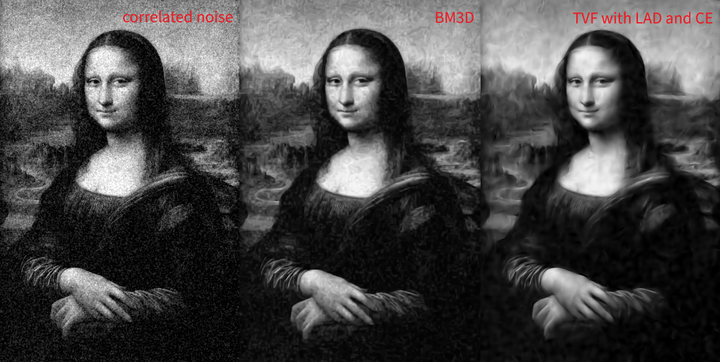Total Variation and Mean Curvature PDEs on the Homogeneous Space of Positions and Orientations (JMIV)
 Comparing how Total Variation Flow deals with correlated noise in comparison with BM3D. Left: the (monochrome) Mona Lisa with added correlated noise, middle: BM3D, right: TVF on $\mathbb{M}_2$ with locally adaptive frames and coherence enhancement.
Comparing how Total Variation Flow deals with correlated noise in comparison with BM3D. Left: the (monochrome) Mona Lisa with added correlated noise, middle: BM3D, right: TVF on $\mathbb{M}_2$ with locally adaptive frames and coherence enhancement.
Abstract
Two key ideas have greatly improved techniques for image enhancement and denoising: the lifting of image data to multi-orientation distributions (e.g. orientation scores), and the application of nonlinear PDEs such as Total Variation Flow (TVF) and Mean Curvature Flow (MCF). These two ideas were recently combined by Chambolle & Pock (for TVF) and Citti et al. (for MCF) for two-dimensional images.
In this work, we extend their approach to enhance and denoise images of arbitrary dimension, creating a unified geometric and algorithmic PDE framework, relying on (sub-)Riemannian geometry. In particular, we follow a different numerical approach, for which we prove convergence in the case of TVF by an application of Brezis-Komura gradient flow theory. Our framework also allows for additional data-adaptation through the use of locally adaptive frames and coherence enhancement techniques.
We apply TVF and MCF to the enhancement and denoising of elongated structures in 2D images via orientation scores, and compare the results to Perona-Malik diffusion and BM3D. We also demonstrate our techniques in 3D in the denoising and enhancement of crossing fiber bundles in DW-MRI. In comparison to data-driven diffusions, we see a better preservation of bundle boundaries and angular sharpness in fiber orientation densities at crossings.
This paper is an extended version of the SSVM paper of almost the same name and was written for the special issue of JMIV following SSVM 2019.